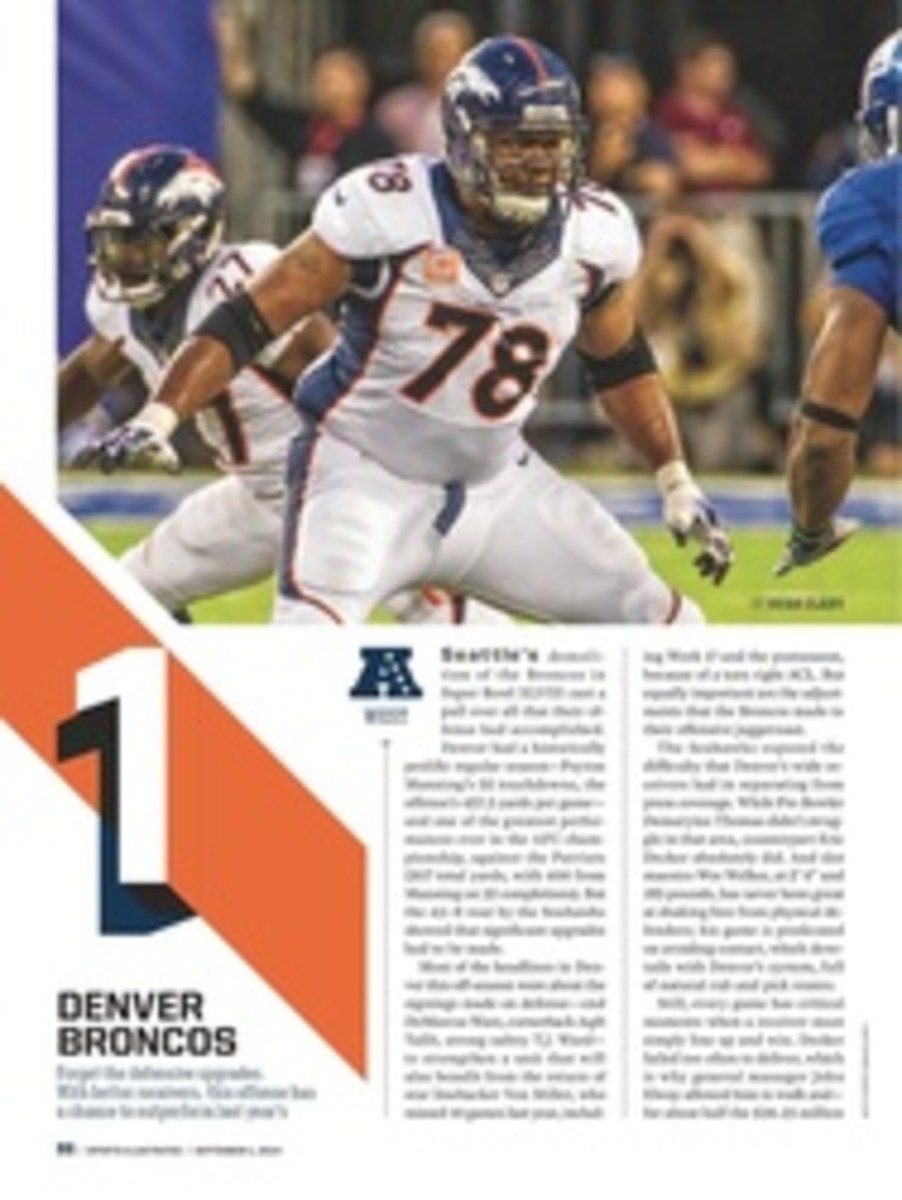
3 TENNESSEE TITANS
Given the pass-happy nature of today's NFL, the last thing a team wants to do is hide its quarterback. But if you have an unrefined or undependable player under center, that's your only chance to be competitive.
Such is the lot of the 2014 Titans, who will start either Jake Locker or rookie Zach Mettenberger. Locker, entering his fourth season but with just 18 career starts because of myriad injuries—including a right hip last season, followed by a right Lisfranc—has good mobility but is still a primitive decision-maker whose mechanics are a work in progress. Mettenberger, a traditional drop-back pocket passer out of LSU, wasn't drafted until the sixth round, but he might be the better fit in new coach Ken Whisenhunt's system.
Whoever starts in Week 1 is by no means a lock to hold the job. But with either quarterback, Whisenhunt will have to do what he failed to do a few years ago in Arizona, after Kurt Warner retired: Amend his scheme to compensate for his signal-caller's limitations.
So how do you "hide" a quarterback? You can't simply stop throwing the ball. (The Tim Tebow--led Broncos of 2011 tried that, but even they wound up taking to the air in crucial moments late in games.) You can, however, be more selective about when you throw.
The best time to throw is on first down, when defenses are geared up to stop the run and are most susceptible to the quarterback-hiding tactic of play-action. Because the QB turns his back to the defense while faking the handoff, he can't read the entire field when he looks back around. Bodies have shifted; he needs time to reassess. Therefore he is asked to read only one side of the field (usually whatever side the run fake went toward). If the primary target isn't open, the next option is to check down to that side. Simple stuff. Quarterbacks who aren't comfortable with making even two reads tend to run more, especially if they're mobile (like Locker).
Another quarterback-hiding maneuver is rolling the pocket. This also slices the field in half while nullifying most pass-rushing concepts, which are built around attacking a quarterback's straight drop-back. Tennessee will move the pocket often if Locker is in. If it's Mettenberger, who does straight drop-backs, more of the quarterback-hiding ploys will involve screens—either slow-developing ones to running backs or quicker ones to wide receivers.
Short catch-and-run routes are also helpful; they create simple either/or reads. This is a tactic the Titans will definitely deploy because they have several receivers who excel at screens and shallow crosses. Their most talented wideout, second-year man Justin Hunter, is a downfield playmaker who's trying to refine his underneath game, but the rest of the group is already there. Nate Washington is cerebral, and third-year pro Kendall Wright offers superb short-area quickness and body control. There's also utilityman Dexter McCluster, a free-agent pickup who was regularly used on the move in Kansas City. And before coming to Nashville last year, tight end Delanie Walker, who will shoulder a larger role in Whisenhunt's system, was an excellent multitooled weapon in a 49ers offense that had to hide its quarterback often.
Walker's versatility extends to run blocking, and the ground game will obviously be essential for sustaining drives. Walker is savvy enough to dictate the entire run-blocking structure with his reads and movement. Blocking is especially important because unless second-round rookie Bishop Sankey from Washington erupts out of the gate, the Titans' lead back will be the methodical veteran Shonn Greene.
At least they've invested in blockers. Last season it was at guard, with Andy Levitre signing for $46.8 million over six years and Chance Warmack being drafted 10th. This season it's at tackle. Former Raven Michael Oher signed for $20 million over four years, most likely not knowing that the club would also use the 11th pick on Michigan's Taylor Lewan, who may start ahead of Oher in 2014 before eventually replacing sound-but-declining left tackle Michael Roos in '15. (In training camp, however, Lewan served as Roos's backup.)
As critical as this O-line's run blocking is to the ground game, it's perhaps more important to the passing attack. After all, what really drives quarterback-hiding tactics such as play-action, rolled pockets and screens is a line's cohesion and movement. If the Titans' front five doesn't come together, their quarterbacks will really need help.
2014 SCHEDULE
2013 Record: 7--9
WEEK 1
KC [AWAY]
DAL [HOME]
CIN [AWAY]
IND [AWAY]
CLE [HOME]
JAX [HOME]
WAS [AWAY]
HOU [HOME]
BYE
BAL [AWAY]
PIT MON [HOME]
PHI [AWAY]
HOU [AWAY]
NYG [HOME]
NYJ [HOME]
JAX THUR [AWAY]
IND [HOME]
WEEK 17
FOCUS ON
Coverage
New defensive coordinator Ray Horton has prospered with his scheme in part because he's had preeminent one-on-one cover cornerbacks in Patrick Peterson (Arizona) and Joe Haden (Cleveland). The closest thing the Titans had to that was Alterraun Verner, but he left for the Buccaneers in free agency. Tennessee's top-paid corner, Jason McCourty, has actually developed nicely since being selected in the sixth round out of Rutgers in 2009. But McCourty is most comfortable as an off-man defender serving as part of a scheme, not as its backbone. He'll have to be the backbone this year, however, because across from him is Coty Sensabaugh, whose experience is primarily in the slot. Horton has two solid safeties in Michael Griffin (more of a coverage guy) and Bernard Pollard (a box hitter), but the coordinator will be constricted in how he uses them unless the corners develop.
THE CASE FOR
Defensive tackle Jurrell Casey
With the Bengals' Geno Atkins injured in Week 9, Casey, a third-round pick in 2011 and a starter since Day One, was the best one-gap defensive tackle in the AFC last year. Casey's mix of initial quickness, second effort and technique was destructive week in and week out—and a rarity for any 300-plus-pounder. He now has to mind two gaps, not just one, under new coordinator Ray Horton, who is shifting the Titans from a 4--3 to a 3--4. Casey will play the hybrid five-technique, the position at which Horton's former disciple, Darnell Dockett, excelled in Arizona. Needing to match Dockett's sensational lateral movement in traffic, Casey shed 15 pounds this off-season. He'll be key in a pass rush that is built not on edge rushers—though Tennessee has several, none has the speed to make offenses alter their protection—but on aggressive blitz designs. Horton's array of pressure packages might be the richest and most creative in all of football. Those packages are most relevant on third-and-long, of course, and for a defense to get to that down and distance, it must first stop the run. Whether that happens depends on how quickly Casey and his fellow Tennessee defensive linemen learn to play two gaps.
PHOTO
WESLEY HITT/GETTY IMAGES
QB JAKE LOCKER
PHOTO
JOSHUA WEISBERG/ICON SMI
NINTEEN PHOTOS

